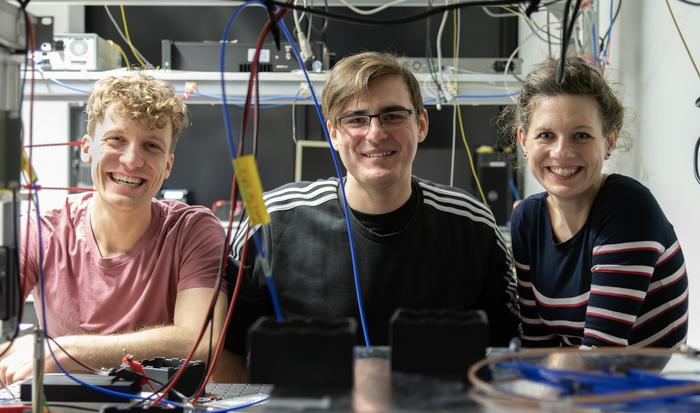Neural networks have become a cornerstone of modern artificial intelligence (AI), mimicking the intricate working of neurons in the human brain. This resemblance allows for impressive learning capabilities in machines, transforming vast amounts of data into actionable insights. A fundamental component of these networks is the activation function, which incorporates nonlinearity, enabling the network to capture complex patterns and relationships in the data. Recently, innovative research has emerged from the Stiller Research Group at the Max Planck Institute for the Science of Light in collaboration with Leibniz University Hannover and MIT, focusing on a groundbreaking development in the field of photonic computing. They have experimentally demonstrated a novel all-optically controlled activation function using traveling sound waves, paving the way for advancements in optical neural networks.
The implications of this research are profound, especially in an era where AI is proliferating across various sectors. AI technologies are progressively enhancing human capabilities in diverse applications, from data scrutiny to image recognition and text generation. The efficiency of these algorithms frequently surpasses human performance, drastically reducing the time required to accomplish tasks that may take hours or even days if done manually. However, a significant challenge lies in the energy consumption associated with training AI models, particularly large language models, which has prompted a concerted effort among scientists to explore alternative computing paradigms that can alleviate this problem.
Artificial neural networks are structured in a complex manner that mirrors the connections found in the human brain. The nodes in these networks communicate through intricate pathways, yet they are predominantly executed via electronic systems, which are known for their significant energy demands. As the demand for more powerful and efficient AI systems grows, there is a pressing need to investigate potential solutions that can either support or replace traditional electronic systems. This has led researchers to explore various physical systems including optical materials, molecular structures, and even biological components like DNA strands and fungi.
One of the most promising areas of research is the intersection of optics and photonics and their potential advantages over conventional electronic systems. Photonics offers a unique set of benefits, including high bandwidth communication and the ability to encode information in high-dimensional symbols. These characteristics enable faster data processing and communication. Photonic systems have advanced considerably and demonstrate the potential for parallel processing, making them a formidable competitor to traditional electronic architectures. Furthermore, scaling photonic systems may lead to lower energy requirements while addressing complex computational challenges, thus making photonic neural networks a tantalizing prospect for future developments in AI.
The Stiller Research Group has been at the forefront of this frontier, focusing on the integration of optoacoustics into optical neural networks. Their recent breakthrough involves the creation of a photonic activation function controlled all-optically, eliminating the need to convert information back to the electronic domain. This innovation is vital for the advancement of photonic computing, representing a step toward achieving energy-efficient artificial intelligence solutions over the long term. In a basic neural network model, the input signals are processed through a weighted sum of incoming data, followed by a nonlinear activation function. While photonic approaches exist for many aspects of this process, the non-linear activation function has historically been underdeveloped, with only a few experimental implementations to date.
The significance of developing a photonic activation function is underscored by the progress made in its design and application. The researchers have demonstrated that sound waves serve as an effective mediator for this activation function, allowing for a seamless operation within existing optical systems. This advancement leverages the principle of stimulated Brillouin scattering, where optical input can effectuate a nonlinear change based on the intensity of the incoming light. This nonlinearity is essential for the functionality of deep learning models, as it enables the network to tackle complex problem-solving tasks more effectively.
Moreover, the new activation function offers versatility, as it can be tuned to generate various mathematical forms, including sigmoid, ReLU, and quadratic functions. Such flexibility enhances the potential applications of this technology, allowing it to adapt to the specific requirements of different computational tasks. This innovation could also benefit from a phase-matching rule inherent to stimulated Brillouin scattering, enabling the processing of multiple optical frequencies simultaneously. This capability could significantly boost the performance of optical neural networks as it allows for enhanced parallel computing.
Maintaining the bandwidth of optical signals while avoiding the inefficiencies of electro-optic conversion is another important advantage of this approach. The incorporation of a photonic activation function into an optical neural network ensures that the integrity of the optical data is preserved, ultimately leading to faster processing times and improved computational efficacy. The sound wave-mediated control of the activation function provides researchers with a powerful tool to fine-tune neural computations, potentially revolutionizing the way that optical systems are harnessed in AI and related fields.
In conclusion, the research spearheaded by the Stiller Group demonstrates a significant leap forward in the realm of optical neural networks. By employing sound waves to control a photonic activation function, this innovative approach not only retains the benefits of optical data transmission but also establishes a pathway for developing more energy-efficient and versatile AI systems. This work has the potential to influence a broad array of applications, from data processing to machine learning, reflecting the ongoing quest for more advanced and sustainable solutions in the field of artificial intelligence.
Subject of Research: Photonic activation functions for optical neural networks
Article Title: All-optical nonlinear activation function based on stimulated Brillouin scattering
News Publication Date: 14-Feb-2025
Web References: http://dx.doi.org/10.1515/nanoph-2024-0513
References: None available
Image Credits: MPL, Susanne Viezens
Keywords
Neural networks, artificial intelligence, photonics, activation functions, energy efficiency, optical computing, deep learning, stimulated Brillouin scattering, optoacoustics, computational performance, machine learning, data processing.




